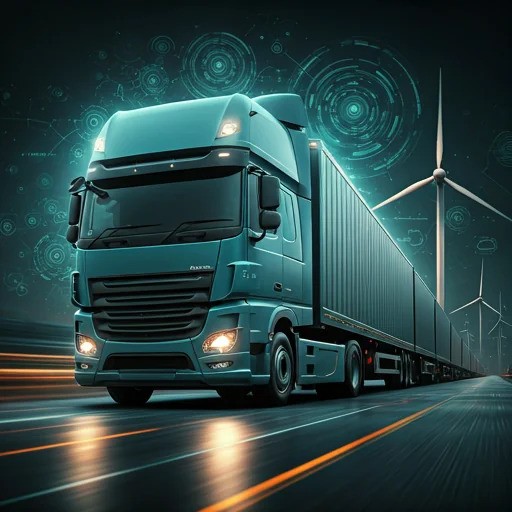House of Dispatch news
Blog
Key Trucking Industry Trends for 2025

As we approach 2025, the trucking industry is poised for significant transformations driven by technological advancements, regulatory changes, and evolving market demands. Staying abreast of these developments is crucial for industry stakeholders aiming to maintain competitiveness and operational efficiency.
Autonomous and Semi-Autonomous Trucking Technologies
The integration of autonomous and semi-autonomous technologies is set to redefine freight transportation. Semi-autonomous features, such as lane-keeping assistance and adaptive cruise control, are becoming standard, enhancing driver safety and reducing fatigue. Fully autonomous trucks, while still under development, promise to revolutionize logistics by potentially lowering labor costs and increasing operational efficiency. However, widespread adoption hinges on overcoming regulatory hurdles and public acceptance.
 Adoption of Electric and Alternative-Fuel Vehicles
Adoption of Electric and Alternative-Fuel Vehicles
Environmental sustainability is at the forefront of industry priorities. The shift towards electric and alternative-fuel trucks is accelerating, driven by advancements in battery technology and supportive regulatory frameworks. These vehicles offer reduced emissions and lower long-term operational costs. Challenges remain, including the need for extensive charging infrastructure and the current high acquisition costs. Nonetheless, as technology matures and economies of scale are realized, these barriers are expected to diminish.
Addressing the Driver Shortage
The industry continues to grapple with a persistent driver shortage, exacerbated by an aging workforce and high turnover rates. Strategies to mitigate this issue include:
- Enhanced Recruitment and Training Programs: Attracting younger demographics through targeted outreach and comprehensive training initiatives.
- Improved Working Conditions: Offering competitive compensation packages, flexible schedules, and wellness programs to retain existing drivers.
- Technological Assistance: Utilizing driver-assist technologies to reduce the physical and mental demands of the job, making it more appealing to potential recruits.
Data-Driven Decision Making and Predictive Analytics
Leveraging big data and predictive analytics is transforming operational strategies within the trucking sector. By analyzing data from various sources, companies can:
- Optimize Routes: Reduce fuel consumption and delivery times through efficient route planning.
- Predict Maintenance Needs: Utilize telematics to foresee mechanical issues before they lead to breakdowns, thereby minimizing downtime.
- Enhance Supply Chain Visibility: Provide real-time tracking information to clients, improving transparency and customer satisfaction.
Real-Time Monitoring and Enhanced Transparency
The demand for real-time tracking and transparency has become a standard expectation. Advanced telematics and Internet of Things (IoT) devices enable:
- Live Tracking: Allowing customers to monitor shipments in real-time.
- Proactive Issue Resolution: Identifying and addressing potential delays or issues promptly.
- Regulatory Compliance: Ensuring adherence to safety and environmental regulations through continuous monitoring.
Globalization and Cross-Border Logistics
Global trade dynamics are influencing trucking operations, with an increase in cross-border transportation. Companies must navigate complex international regulations, tariffs, and cultural differences. Strategies to manage these challenges include:
- Compliance Management: Staying informed about international trade laws and ensuring all operations adhere to them.
- Cultural Competence: Training staff to understand and respect cultural differences to facilitate smoother international interactions.
- Efficient Documentation: Streamlining paperwork and utilizing digital solutions to handle customs and border requirements efficiently.
Customer-Centric and Agile Supply Chains
Modern supply chains are evolving to be more customer-centric and agile, capable of responding swiftly to market changes. This involves:
- Flexible Logistics Solutions: Offering customizable delivery options to meet diverse customer needs.
- Rapid Response Mechanisms: Implementing systems that can quickly adapt to disruptions, such as natural disasters or sudden demand spikes.
- Collaborative Partnerships: Building strong relationships with suppliers and customers to foster a responsive and resilient supply chain.
Anticipated Decline in Trailer Production
Industry forecasts suggest a decline in trailer production in 2025, attributed to cautious capital expenditure and existing overcapacity. While specialized units like refrigerated trailers may maintain stable demand, overall production is expected to remain subdued until market conditions improve. Supply chain stabilization and a gradual freight recovery in the latter half of the year may provide a modest boost to production.
Increase in Long-Distance Freight
The trucking industry is anticipated to experience a rise in long-distance freight demands in 2025 and beyond. This trend is partly due to projected increases in both air and ocean freight, underscoring the interconnectedness of global supply chains. As more goods flow through ports and airports, trucking companies will play a vital role in ensuring efficient and timely delivery to final destinations.
Projected Growth in Truck Freight Volume
According to the American Trucking Associations, total truck tonnage is expected to grow from an estimated 11.27 billion tons in 2024 to 13.99 billion tons in 2035. Correspondingly, industry revenues are projected to increase from $906 billion to $1.46 trillion, accounting for 76.8% of the freight market by the end of this period.
Key Trends to Watch: Tariffs, Mergers and Acquisitions, and Rate Changes
Industry stakeholders should monitor developments in tariffs, mergers and acquisitions (M&A), and rate fluctuations. Uncertainties surrounding tariffs can impact cross-border operations, while M&A activity is poised to target niche services, potentially reshaping the competitive landscape. Staying informed about these trends will be crucial for strategic planning.
Conclusion
The trucking industry in 2025 is set to navigate a landscape marked by technological innovation, environmental considerations, and shifting market dynamics. By proactively embracing these trends, companies can position themselves for sustained success in an evolving environment.
